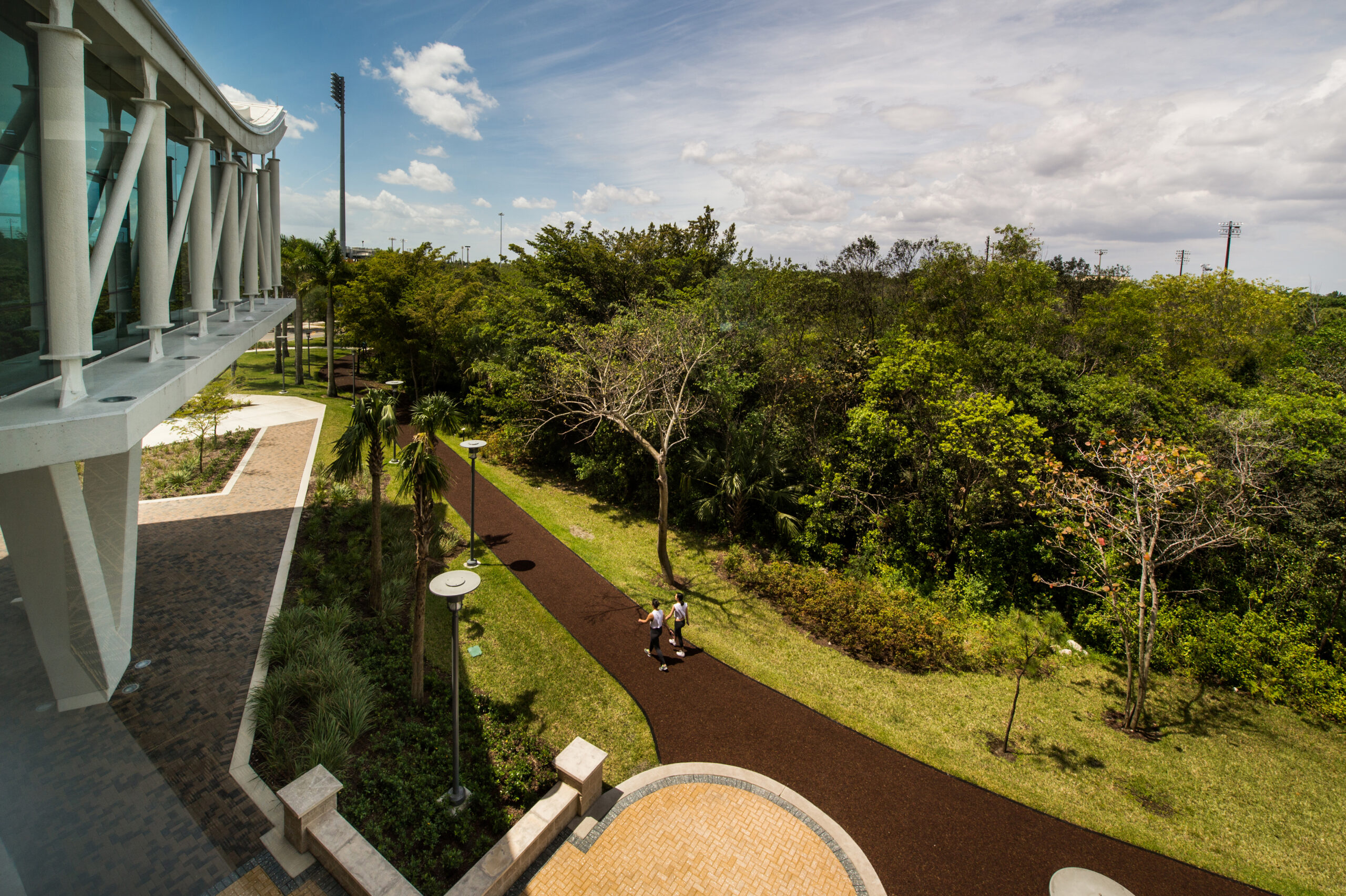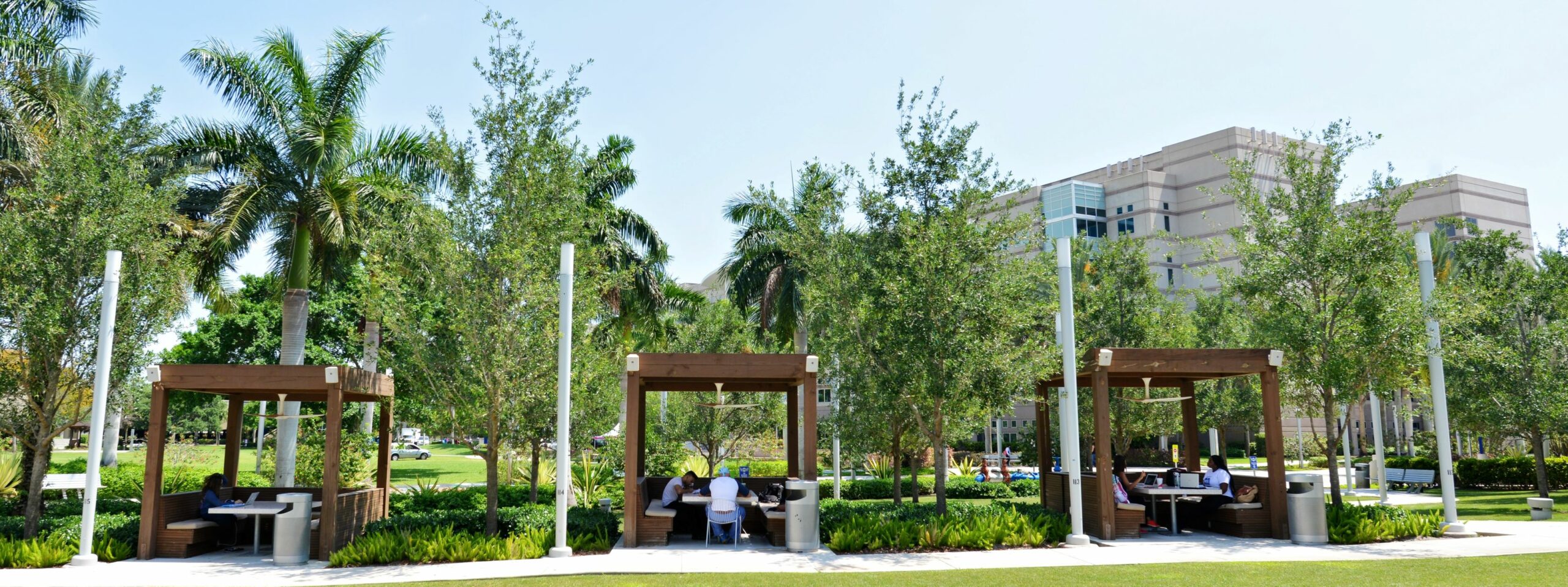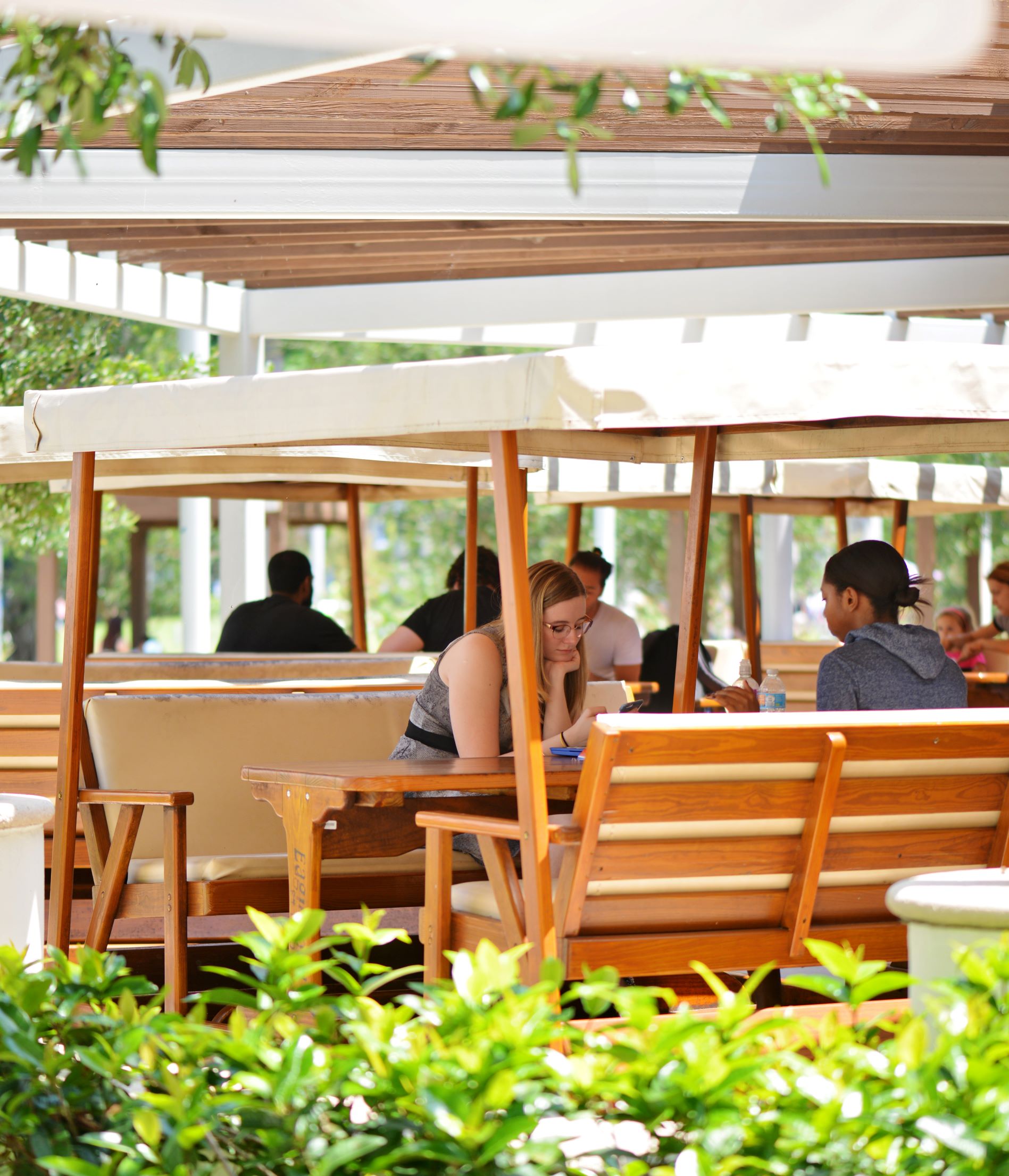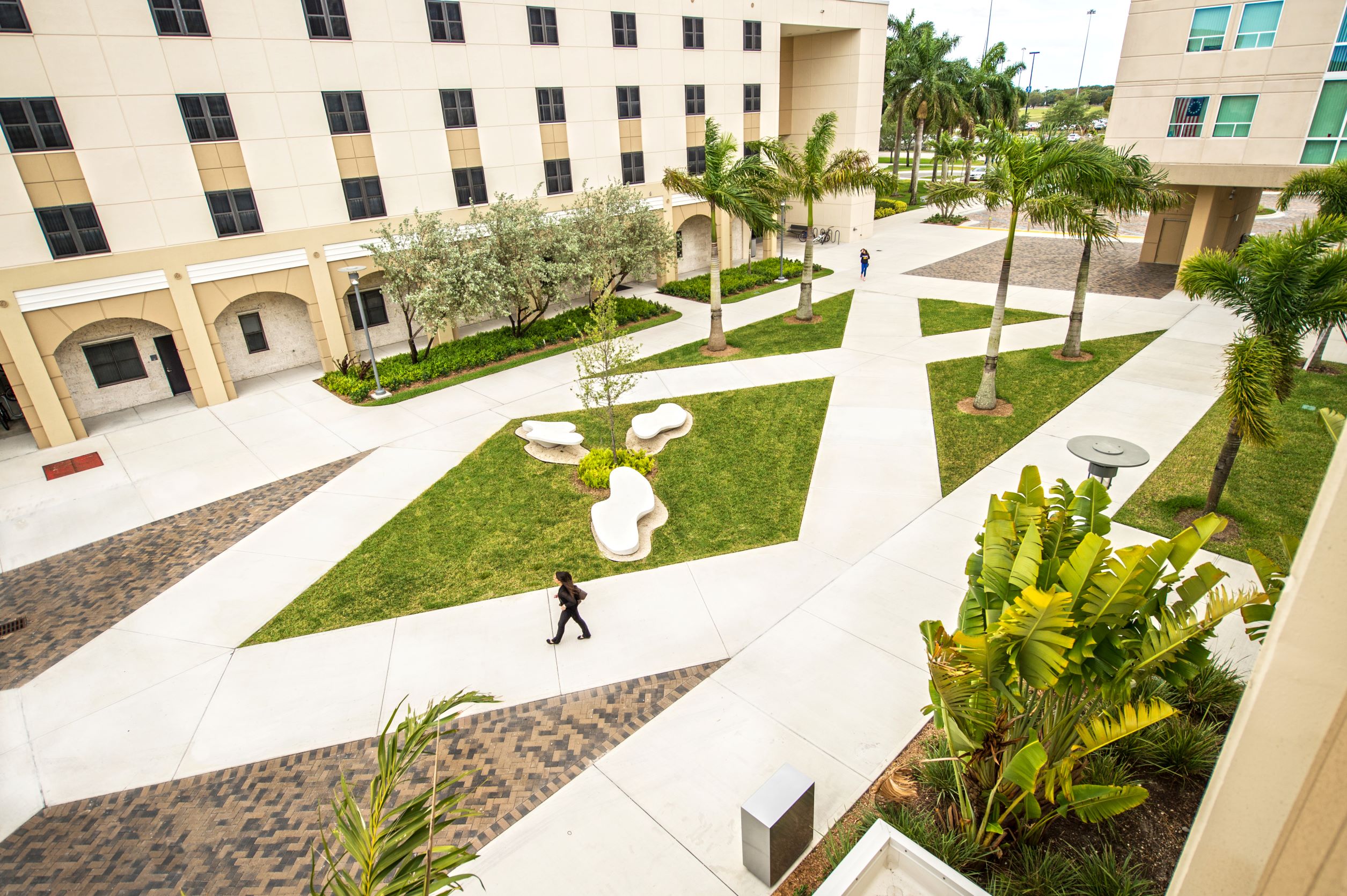“An asphalt lot is such a waste of space. The land is very precious and valuable. As landscape architects and planners, this is our mantra: don’t mess with the land. If we take care of it, it will take care of us.” – Kona Gray
Kona Gray is a landscape architect and Principal at EDSA, which has been behind some of the world’s most unique designs including the Atlantis Paradise Island, Savannah’s streetscapes, the Cosmopolitan hotel in Las Vegas and many of Dubai’s stunning hotels and islands. It also has creatively reshaped and honed some dynamic campuses, including two beauties in South Florida – Nova Southeastern University and Florida International University.
Though close to Miami and Fort Lauderdale and with space at a premium, each boasts alluring outdoor spaces – a key during the COVID-19 pandemic – where cabanas, covered patios, pathways and terraces offer vibrant yet relaxing areas for administrators, students and faculty to gather.
For those institutions that lack similar resort-style amenities or are hamstrung by campus flow, an integrated makeover may be in order. The Society for College and University Planning stresses the importance of the use of space for institutions to meet strategic and academic goals. The SCUP says in its guidance that “a campus can be nurturing. It can be inviting. It can be stimulating. It can be the physical manifestation of an institution’s mission, a reminder of the promise and potential waiting to be unleashed.”
Cohesive campus planning and long-term vision can ensure they are keeping up with trends and meeting student needs. Gray says bringing those exterior spaces to life is one way colleges can set themselves apart, now and in the future.
University Business sat down with Gray to get his take on outdoor design trends and some of the key elements that colleges may be overlooking when redesigning those spaces:
Where are campuses going with their design, especially in this age of COVID?
The No. 1 thing that we were able to do on many of the university campuses we serve was to help reemphasize the spaces between buildings. That trend has actually been accelerated due to COVID.
Universities also have been relying on parking lots right next to buildings. [We said] ‘why don’t you remove that parking and create a plaza space or create a place of gathering for students? Or create a small amphitheater where you can maximize some opportunities for teaching. Maybe you’re pushed for space in the interior, but if you use this outdoor amphitheater, you could actually make that happen without having to build a new building.
We’re also going to flexible spaces outdoors, where you can use a space for morning yoga, then for a classroom setting and then later in the day for an assembly.

What are some of the biggest design challenges you’ve encountered and some solutions?
Big challenges are weather, technology and having access to power. In the case of weather, instead of building at $400-$500 per foot for a new building, you can build a small pavilion that allows you to be indoors but still have that outdoor feel. We’ve recommended using outdoor tents to allow activities to occur. Sometimes these are temporary but end up being more permanent. Even those in northern climates are realizing, it may be cold, but you can use heaters.
Our clients have real-world issues, including COVID. The back-to-school push was contingent on getting people together safely. How do we space them out, especially on campuses that are already overloaded?
The simple things are the challenges. Having strong wi-fi throughout your campus. Having spaces that have opportunities for you to plug in. The idea of outdoor classrooms, one thing that gets missed is all the stuff that goes with it: outdoor writing utensils, whiteboards or blackboards, having access to restrooms. Those are the little things that sometimes get overlooked.
Cost is always a consideration for colleges and universities. Have you seen a ratcheting back of spending? It doesn’t seem like it, with construction projects and new exterior design happening throughout the pandemic.
Universities and colleges are competing for the same bodies. With the advent of online resources, they have another bite at their market share. Many students are saying, ‘I don’t need to be on a college campus. I can do this from my home, especially when half of their classes are taught virtually.’ So the light bulb goes off. What’s the value here? What am I spending money on? Campuses are building and continuing to move forward.
Students are looking for residence halls that have a much higher level of quality than they did in the past: resort-style pools, amenities, things for them to do. Because it isn’t just about learning. It’s about socializing and wanting to be in a space that’s nice. The whole idea of study pods, which came off of the cabana idea, has really resonated with a lot of our clients. We see that as a major trend going forward. We all remember the days of going to a university when it just wasn’t so nice. That’s not where universities are going now. A lot of that has to do with demand.
Other than buildings or structures, how much consideration is being given to walkways, pathways, plantings and elements that tie their campus together in a modern way?
The elements that make a landscape are very important – the furniture, the places for people to rest and hang out, good lighting. We know that when prospective students are going to a campus, they come back and check it out at certain times of the day.
And then simple circulation. We want to make sure that it’s easy to get around, it’s easy to understand where you are. It’s easy to see the nodes of activity where people gather – basic campus planning of situating spaces between the buildings where people gather, but also where people cross paths, where you’ll see your friend on your way to your next class, or you’ll be able to grab a professor as they’re leaving the class and have a little bit more opportunity to talk with them. Making it more walkable – the traditional college setting, as you see people walk into the quad. You look at Harvard, that’s why Harvard Yard is so monumental. Those types of spaces really matter.
What about using bridges or elevated walkways as both design elements and to help traffic flow?
We always tell clients, if you’re going to build a bridge, program it. Do something with that space so the bridge becomes wide enough where you can actually have activities happening on it, like The High Line in New York, where you have an elevated park on your campus. That’s a big idea that I’m sure a lot of universities have overlooked. They are simply thinking, we’ve got to get students from here to there. In some of our master plans, we promoted land bridges and things of that nature, allowing more activity to happen when you’re crossing circulation. It’s costly, but at the same time if you program it, then you can monetize it.
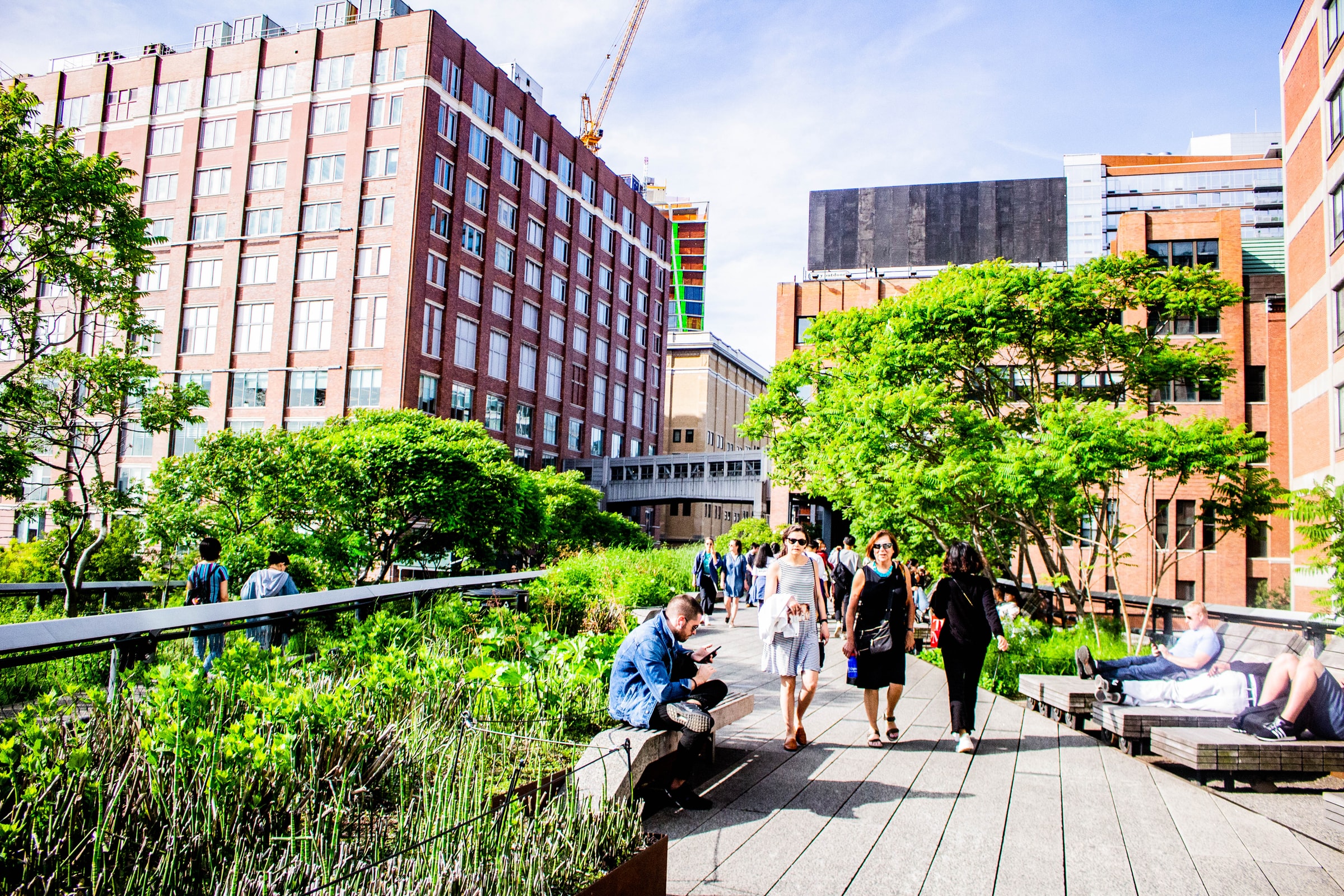
We’ve seen really innovative uses of outdoor spaces at urban campuses over the past few years. What can city colleges do to take advantage of their lack of acreage?
A land-grant institution has hundreds of thousands of acres versus a city campus that’s maybe on 20. What it means is that your spaces become that much more important. Finding ways to wrap those courtyards in between spaces. Taking advantage of your roofs, what we call the fifth façade. A lot of cities, especially New York and Chicago, really take advantage of roof decks and terraces. That’s a wonderful opportunity for classroom spaces that break out from those buildings. Those buildings aren’t just indoors. You have the opportunities to be outdoors. But you have to think vertical. You can’t go horizontal in these urban conditions.
Are a lot of colleges taking advantage of the roofs they have?
Not as many as you’d think. We are members of the Society for College and University Planning. Some of the data that I’ve been seeing on these urban campuses haven’t touched on that. I think I might be writing a white paper on that soon!
What about other elements where campus design is breaking from the norm?
The space at Nova Southeastern has cabanas. Their main Student Center has a restaurant called the Flight Deck, and outside, we did a kitchen bar area for students to hang out, watch games and just be together. We will continue to see that. Outdoor seating areas for activities and dining is definitely the way to go. Having a Starbucks-type situation on your campus where you have a large outdoor patio, where people can hang out, grab a coffee and study makes a major, major difference. I studied at the University of Georgia, and Athens is such a great downtown setting for a university”there are cafes and outdoor seating everywhere. Students are studying all day or they’re just socializing. That’s how you build that activity.
What about residence halls? What looks different now than say 10-15 years ago?
They’re not the same. They’re really high-end. The Res Hall we completed at Florida International University (above) is really great”they actually elevated the building in some portions so you have social rooms that break out to an outdoor space that is covered but open on the sides. So there’s ping pong, foosball, little lounge areas. It is amazing and students love it. We’re creating a lot of spaces with residence halls that allow students to want to be there. From a financial standpoint, res halls sometimes cost as much as tuition. It really is a major economic generator for universities. The main purpose is to have you on campus so you can really experience college life. But for the commuter, they need that space, too. On many campuses, we’ve designed spaces where people that drive in can have a place to hang out, so they’re not just getting in their car and leaving.

